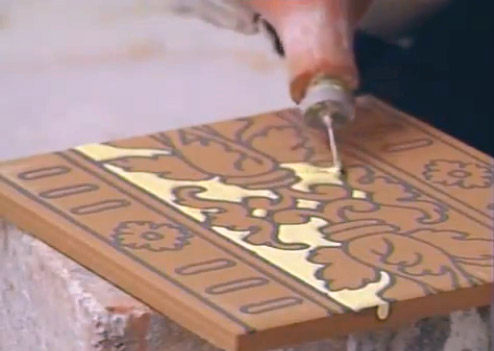Manufacturing process of tiles embossed

The production process comprises:
6 steps in the biscuit section:
- Grinding and wetting of clays.
- Pressing of the pieces.
- Drying of the added moisture during milling.
- Loads of parts for trucks firing.
- Firing.
- Download and palletizing.
4 steps to the glazed section:
- Glazed bisque parts.
- Firing and classification.
- Reflection of copper.
- Storage of the final product.
In all these steps, the most respected technique used in traditional Andalusian production of ceramics, although this is not the use of latest technology is excluded, so that result is achieved as a traditional high quality ceramic.
Section bisque
Grinding and wetting of clays :
Clays of different types are collected , prepared and stored for the summer months , because you have to dry them in the sun to remove all the moisture they contain.During the rest of the year , these clays are rescued from the stores and are transported to a mill where the grain size is given , the level of humidity and mixed by the percentage set to work with them in the presses. Once the clay is prepared , passes within silos where compacted and homogenized prior to use in printing presses.
Pressed Parts:
From the aforementioned silo passes clays presses , where the pressure is controlled so as the pressure time and other parameters , for a perfect biscuit compaction is achieved. In the press molds are used , whereby both are modified format , as the thickness and other characteristics of the parts being produced .Example: flooring, leaks , platelets , reliefs , smooth, beveled , trims, etc.
Drying of moisture added during milling :
After pressing the clay and prior to the baking of the biscuit has been to remove any moisture contained therein. Otherwise , the pieces presented cracks and flaws that would not be valid for subsequent sale or enamelled . This moisture is removed in dryers , which can be fast type (vertical) or traditional type (manual). In fast drying , the dried pieces are mostly intended for sale as biscuit ( SOLERIAS and leak ) , while the dried pieces in traditional dryers are intended for subsequent enameling .
Loading the wagons parts for firing :
Before firing, the pieces have to be loaded into a form suitable wagons for the same temperature and air flow across the surface , since otherwise the pieces would present very notable differences in tone and other irregularities. This cargo wagons is done automatically in the parts for sale as biscuit ( SOLERIAS and leaks ) and parts manually or with special format intended for glazing later. Once the process of loading trucks , these tunnels pass called prehornos in which protected from changes in temperature and humidity are maintained until entering the kiln .
Firing :
The baking of the biscuit is the most important point of the process , and that here the end product is obtained . The baking time is approximately 24 hours and has to maintain a curve (temperature - time - distance ) perfect for optimum results . The values and parameters to be applied in this process are monitored 24 hours a day by trained operators.
Download and palletizing :
After firing, the pieces are manually unloaded from the wagons , and go through a selection to reject not valid . Once selected, the final product becomes palletizing.Automatically held for sale as biscuit ( SOLERIAS and leaks ) . Manually special formats or devices intended for posterior enamel . In both cases, once palletizing, the product is stored in specific pending or later glazed marketing locations.
Glazed pieces of biscuit:
From cupcakes stores are rescued parts to proceed to its glazed . These pieces may be embossed , smooth, decorated or special parts , performing a different process for the enamelling of each . The pieces are glazed highlighted manually with updated techniques, this being the most expensive to produce because it requires a very high hand work. The artistic range ( decorated ) is glazed by a mixed process . First a layer of enamel is applied in a glazing line to smooth, and then decorates semi-automatically . Finally , smooth and special pieces are enameled automatically in line for such use , applying the glaze over the biscuit with glazed bells or curtains . All our pieces are replicas of the legacy of the Spanish- Moorish Muslim culture and art of the fourteenth and fifteenth centuries. Once completed any of the processes described above, the pieces are stored in specific compartments for such use , and are waiting to be cooked .
Firing and rating :
Baking enamel parts is , as in the biscuit , one of the most important points of the entire process , because here is the final product obtained. In this case , the baking time is between 70 and 90 minutes, and the biscuit was precooked . During the whole process has to maintain a curve (temperature - time - distance ) perfect for optimum results , and the values of these parameters are monitored 24 hours a day by trained operators. Once finished firing , the pieces are manually selected and reject those that do not meet established quality values .
Reflection of copper:
A part of the finished product from the muffle furnace , it is subjected to chemical reactions ( oxidation - reduction ) at a third firing to obtain copper luster on the workpiece . This process is performed using traditional techniques that are centuries old , and parts are obtained as a result of exceptional quality and beauty.
Storage of the final product :
After passing the selection of quality, all products mentioned above are glazed packaged and referenced , and go to specific locations to be stored awaiting commercialization.
